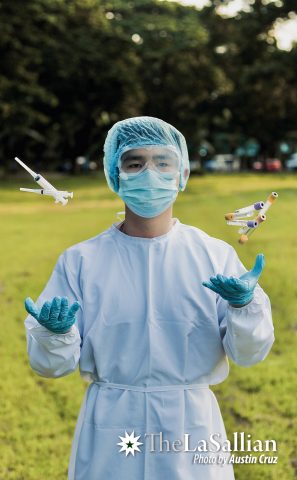As the government lifts quarantine restrictions, optimism abounds that the country could soon see the resolution to this two-year pandemic. With businesses in areas under Alert Level 1 resuming their operations at full capacity, most Filipinos can now go out and travel, regardless of age or comorbidities.

While no one can conclusively tell when the COVID-19 pandemic will end, San Lazaro Hospital Adult Infectious Disease and Tropical Medicine Unit Head Rontgene Solante lists vaccine formulation, treatment, and host identification as vital strategies in controlling and managing COVID-19 cases.
In particular, Solante raises that there is still no substantial evidence about the host origin of the SARS-CoV-2 virus, unlike SARS-CoV-1 and MERS-CoV, which are vectored by bats and dromedary camels, respectively. As such, finding an ultimate resolution to SARS-CoV-2 will be more difficult without clear evidence of its origins.
With this mystery left unraveled, can one expect to witness the end of this pandemic?
The past
History keeps a record of infectious diseases that have emerged and spread across the globe. Among the most notable are the Bubonic Plague, 1918 influenza pandemic, SARS-CoV-2, and MERS-CoV.
Among these outbreaks, the bubonic plague is considered the deadliest. At its peak between 1347 and 1351, it killed around 30 to 50 percent of the affected population, according to DeWitte in 2014. However, in comparison to the COVID-19 pandemic, outbreaks of the bubonic plague were mostly local due to the limited movement of people—not many were able to travel—and thus, the probability of transmission was reduced.
On the other hand, the COVID-19 virus has successfully proliferated through increased trade and travel, which are brought about by globalization. It must be noted that these two factors—alongside the emergence of urbanization—have furthered global interconnection, which has essentially contributed to the spread of the virus. Overall, the interplay among these factors has made globalization an effective means of disease transmission.
Not to mention that SARS-CoV-2 also originated from a highly populated location that can easily prompt an exponential growth in transmission rates. According to University of Santo Tomas Associate Professor Bernhard Egwolf, this characteristic is highly dangerous, as it can entail a quick surge of cases. “You start with a few people who are infected and in a few weeks, you already have millions of people infected. This is an exponential growth,” he elaborates.
The same phenomenon was observed in previous disease outbreaks, such as the influenza pandemic in 1918. Egwolf posits that it is comparable to the COVID-19 pandemic in terms of the exponential nature of their transmission rates.
Apart from effecting an exponential growth in cases, SARS-CoV-2 can also mutate to its advantage, warns Solante. These mutations may make the virus more transmissible, violent, and even evasive of current vaccines—as observed in the later Delta and Omicron variants.
The current
While the end of the pandemic is seemingly in sight, it is vital to steer clear of complacency since the various new COVID-19 variants still pose a threat. “Whenever a new variant shows up, the number of infections also goes up,” highlights Egwolf. Such a relationship was exemplified by the surge of cases stemming from the Omicron variant back in January of 2022.
Nonetheless, there are also factors of hope that could motivate the pushing through to the end of the pandemic. Both Egwolf and Solante emphasize the importance of having vaccinations as well as booster shots. With the gradual reopening of schools, children must receive vaccinations as well. “Vaccinating everyone is the goal of controlling this pandemic,” advises Solante.
Treatment through monoclonal antibodies—which assist the immune system in responding more effectively to the virus—and antiviral medications can also aid symptomatic individuals in preventing the contraction of more infectious strains of the disease.
In addition, compliance with health protocols such as observing physical distancing, wearing face masks, and going into quarantine when symptomatic or infected is crucial in lowering the quantity of COVID-19 cases. Although these are simple regulations that have been followed for the past two years, compliance remains pertinent particularly because new variants are more infectious.
Egwolf asserts that people should continue practicing preventive measures such as the improvement of indoor ventilation and conformity to lockdown policies to help reduce the spread of COVID-19—since the new variants are getting more infectious.
The end?
The storied saga of COVID-19 has undoubtedly led to a plethora of assumptions about how it would end. For instance, some scientists, namely virologists and infectious disease specialists, hypothesize that the pandemic can be ended with a highly effective vaccine delivered to every individual worldwide, while some also speculate that, although the virus will not vanish completely, it will diminish into a seasonal illness.
In a scenario where the spread of COVID-19 becomes endemic, Solante postulates that those most susceptible to the virus include the economic workforce, the immunocompromised, and comorbid individuals. “Even with a low number of cases, [their] ability to protect themselves against [the] virus will be totally different because of their condition,” he affirms.
It is also said that the end of the pandemic can be signaled by a controllable amount of hospitalizations and a significant decrease in the number of deaths daily, as per Centers for Disease Control and Prevention Director Dr. Rochelle Walensky. This can lead to the transition toward an environment where people can go out without face masks. “We have to find a way to be done with [masks],” Walensky states.
The pandemic is not yet over, but it certainly will not last forever. With all this in mind, people must remain vigilant against the virus. While vaccines can be administered and treatments are present, no one is fully safe from COVID-19—as it simply cannot be treated like any other flu.
Amid the rise of cases, the bullet of complacency must be bitten; one must keep their guard up and take measures like conformity to health regulations to hold up one’s end of the bargain in seeing this pandemic’s conclusion.
